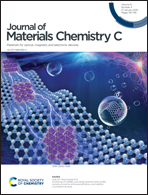Tunneling-assisted highly sensitive and stable lead-free Cs3Bi2I9 perovskite photodetectors for diffuse reflection imaging
Abstract
Lead-free perovskites exhibit low toxicity and have been investigated as new active materials for photoconversion applications. Among them, Cs3Bi2I9 perovskites have received extensive attention due to their eco-friendliness, excellent stability and high photosensitivity. Herein, the optical and electronic bandgap of Cs3Bi2I9 thin films are determined to be 2.19 eV and 2.55 eV, providing insights into strong excitonic photodetection materials. Furthermore, we introduce an ultrathin Al2O3 layer into the interface of Cs3Bi2I9 perovskite PDs using the atomic layer deposition (ALD). The ON/OFF ratio can be significantly improved by 20-fold using an Al2O3 layer with an optimal thickness of 1.5 nm due to the interfacial-tunneling-effect. Moreover, the unsealed Cs3Bi2I9 perovskite PDs exhibit excellent stability, and can retain 90% of their original performance after 30 days under ambient conditions (25 °C, RH = 60%). Furthermore, the potential application in diffuse reflection imaging has been explored based on Cs3Bi2I9 perovskite PDs without encapsulation, confirming a high-resolution and high-contrast imaging demonstration.



 Please wait while we load your content...
Please wait while we load your content...